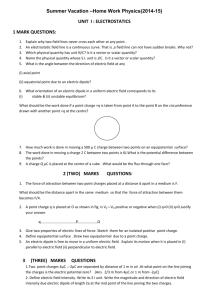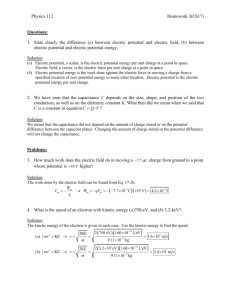1 - mark questions
advertisement
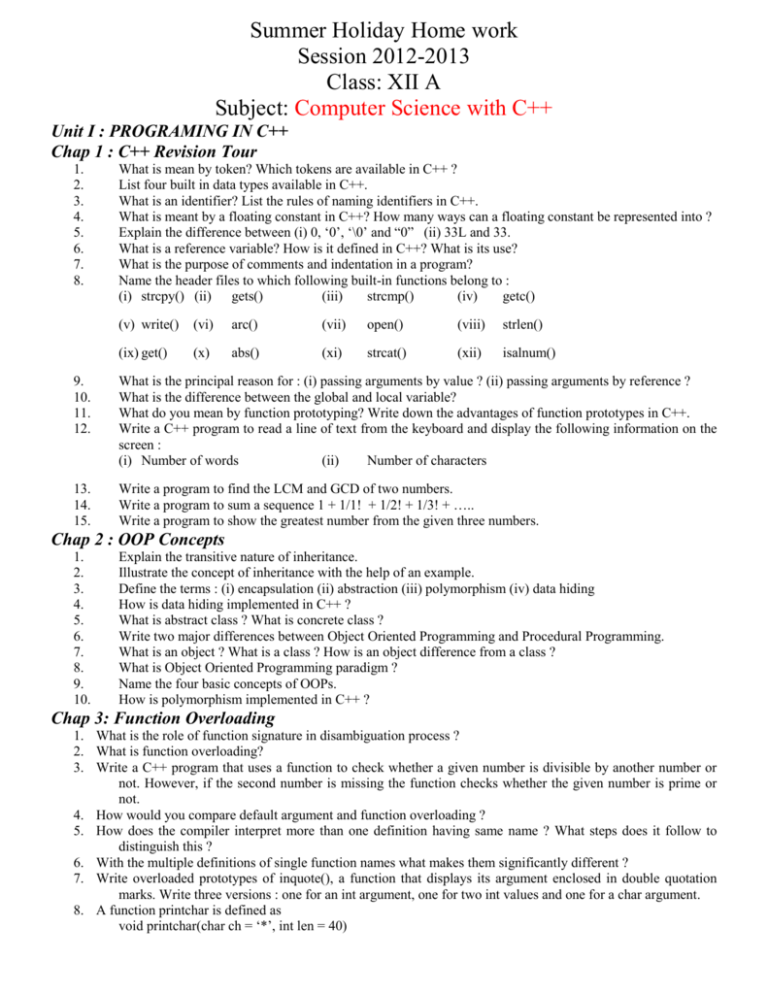
Summer Holiday Home work
Session 2012-2013
Class: XII A
Subject: Computer Science with C++
Unit I : PROGRAMING IN C++
Chap 1 : C++ Revision Tour
1.
2.
3.
4.
5.
6.
7.
8.
What is mean by token? Which tokens are available in C++ ?
List four built in data types available in C++.
What is an identifier? List the rules of naming identifiers in C++.
What is meant by a floating constant in C++? How many ways can a floating constant be represented into ?
Explain the difference between (i) 0, ‘0’, ‘\0’ and “0” (ii) 33L and 33.
What is a reference variable? How is it defined in C++? What is its use?
What is the purpose of comments and indentation in a program?
Name the header files to which following built-in functions belong to :
(i) strcpy() (ii) gets()
(iii)
strcmp()
(iv)
getc()
(v) write()
(vi)
arc()
(vii)
open()
(viii)
strlen()
(ix) get()
(x)
abs()
(xi)
strcat()
(xii)
isalnum()
9.
10.
11.
12.
What is the principal reason for : (i) passing arguments by value ? (ii) passing arguments by reference ?
What is the difference between the global and local variable?
What do you mean by function prototyping? Write down the advantages of function prototypes in C++.
Write a C++ program to read a line of text from the keyboard and display the following information on the
screen :
(i) Number of words
(ii)
Number of characters
13.
14.
15.
Write a program to find the LCM and GCD of two numbers.
Write a program to sum a sequence 1 + 1/1! + 1/2! + 1/3! + …..
Write a program to show the greatest number from the given three numbers.
Chap 2 : OOP Concepts
1.
2.
3.
4.
5.
6.
7.
8.
9.
10.
Explain the transitive nature of inheritance.
Illustrate the concept of inheritance with the help of an example.
Define the terms : (i) encapsulation (ii) abstraction (iii) polymorphism (iv) data hiding
How is data hiding implemented in C++ ?
What is abstract class ? What is concrete class ?
Write two major differences between Object Oriented Programming and Procedural Programming.
What is an object ? What is a class ? How is an object difference from a class ?
What is Object Oriented Programming paradigm ?
Name the four basic concepts of OOPs.
How is polymorphism implemented in C++ ?
Chap 3: Function Overloading
1. What is the role of function signature in disambiguation process ?
2. What is function overloading?
3. Write a C++ program that uses a function to check whether a given number is divisible by another number or
not. However, if the second number is missing the function checks whether the given number is prime or
not.
4. How would you compare default argument and function overloading ?
5. How does the compiler interpret more than one definition having same name ? What steps does it follow to
distinguish this ?
6. With the multiple definitions of single function names what makes them significantly different ?
7. Write overloaded prototypes of inquote(), a function that displays its argument enclosed in double quotation
marks. Write three versions : one for an int argument, one for two int values and one for a char argument.
8. A function printchar is defined as
void printchar(char ch = ‘*’, int len = 40)
{
for (int x = 0; x < len; x++)
cout << ch;
cout << endl;
}
How will you invoke the function printchar for following output :
(i) to print ‘*’ 40 times
(ii)
to print ‘*’ 20 times
(iii) to print ‘=’ 40 times
(iv)
to print ‘=’ 30 times
Chap 4 : Classes and Objects
1.
2.
3.
4.
5.
6.
7.
8.
What is the purpose of class specifier (declaration) ?
What are objects ? How are they created ?
What do you understand by a nested class ?
How does a class accomplish data abstraction and encapsulation?
When we do declare a member of class static ? How are static members different from non static members
of a class ?
What is the significance of a scope resolution (::) operator ?
When will you a function inline and why ?
Define a class to represent a book in a library include the following members :
Data members :
Bookno, Book name, Author, Publisher, Price, No of copies, No of copies issued
Member function :
1. To assign an initial value
2. To assign a book after checking for its availability
3. To return a book
4. To display book information
9.
10.
Declare a class to represent a bank account of 10 customers with the following data members :
Name of the Depositors, A/c No, Type of A/c (S for saving, C for current), Balance amount
The class also contains member functions to do the following :
1. To initialize the data members.
2. To deposit the money.
3. To withdraw money after checking the balance (min balance is 1000)
4. To display the data members.
Define a class of student with the following specifications :
Private members of class student
Admno
integer
Sname
20 characters
Eng, math, science
float
Total
float
Ctotal(): A function to calcuate eng + math + science with float return type Public member functions of
class student
Takedata(): A function to accept values for admno, sname, eng, math, science and invoke ctotal() to
calculate total, showdata() function to display all the data members on the screen.
Holiday Home work 2012-13
Economics
CLASS-XII
Calculate Marginal opportunity cost(MOC) and draw production possibility curve
from the following data :
Production
X-Good
Y-Good
MOC
Possibilities
A
o
90
B
2
80
C
4
60
D
5
45
E
6
25
F
7
0
Write down 10 example statements of each:
(a) Positive approach
(b) Normative approach in Economics
From the following Market Demand Schedule calculate Market Demand and draw all
four demand curves(A’ demand curve, B’ demand curve,
C’ demand curve and market demand curve):
Price
A’ demand
B’ demand
C’ demand
Market
Demand
1
20
10
14
2
18
8
12
3
16
6
10
4
14
4
8
5
12
2
6
The demand function of a consumer is 30-P.Calculate market demand function if there
are 15 consumers in the market.
Calculate market demand function If there are two consumers in the market and
consumer A’s demand function is 20-P and consumer B’s demand function is 30-P.
Calculate elasticity of demand(ed)with the help of Total expenditure method from the
following table:
Price
1
2
Total expenditure
40
60
Decline in the price of Good Y by Rs. 5 cause an increase in the demand of 20 units and
it goes up to 50 units. If initial price is Rs.15, calculate ed.
Calculate ed with the help of percentage method from the following:
Quantity
20
30
Total expenditure
100
120
The price of a commodity increases from Rs. 10 to Rs.25.This leads to the decrease in
the demand from 20 units to 10 units. Calculate elasticity of demand of the consumer.
When the price of a commodity falls from Rs 30 to Rs 20 the demand of the
commodity increases 50 units. If initial demand is 50 units and ed is 2, calculate new
demand.
Calculate the status of a consumer equilibrium from the following given MU schedule
given that Px=Rs 5, Py=Rs 2 and income of the consumer is
Rs 22:
No. of units consumed
MUx
MUy
1
30
20
2
25
18
3
20
16
4
15
14
5
10
12
6
5
10
7
1
8
Given that Money income=20, Px=5, Py=2 find consumer’s equilibrium from following
schedule:
Units of
1
2
3
4
5
6
goods
MUx
50
40
30
20
10
0
MUy
24
22
20
18
16
14
Complete the following table:
No. of units consumed
Total Utility(TU)
Marginal Utility(MU)
1
10
?
2
?
8
3
25
?
4
?
6
5
34
?
6
?
0
The consumer is consuming two commodities. The price of x-good is Rs 4 and of ygood is Rs 5. The income of the consumer is Rs 20.
(a) Write down the equation of the budget line.
(b) What is the slope of budget line.
(c) Make all possible bundles.
(d) Write the bundles which cost the consumer exactly equal to his income.
(e) Make the bundles when the consumer spends half of his income.
Complete the following table:
Price
Demand
Market
demand
Household A Household B Household C
7
16
15
51
8
18
13
46
9
16
12
39
10
13
10
7
The quantity demanded of a commodity at a price of Rs 8 per unit is 500 units. Its price
falls to Rs 6 and as a result, the quantity demanded rises to 600 units. Calculate price
Elasticity of demand.
Solve all the questions given in the 1st UNITWISE CT SERIES
(2 sets containing 14 questions)
Preparation for the 2nd UNITWISE CT SERIES based on UNIT-2
(Consumer Equilibrium)
** Prepare the formula chart of Consumer equilibrium containing all the
formulas.
NCERT Questions related to Introduction and Consumer’s behavior units.
………………………………………………………………………………………………..
Subject: Chemistry
CHAPTER:1- THE SOLID STATE
1 - MARK QUESTIONS
1.
MgO has NaCl structure , what is the coordination number of both ions.
2.
What type of substances would make better permanent magnets, Ferromagnetic or Ferrimagnetic.
1
3.
In corundum, oxide ions are arranged in hcp arrangement and the aluminium
ions occupy 2/3 of the octahedral voids. What is the formula of corundum ?
4.
1
1
A compound contains two types of atoms - X and Y. It crytallises in a cubic lattice
with atom X at the corners of the unit cell and atoms Y at the body centre. What is the
5.
simplest possible formula of this compound?
1
Name the type of point defect that occurs in a crystal of zinc sulphide.
1
2 - MARKS QUESTIONS
6.
If the atoms of an element have the radius r, then in a primitive cubic unit cell,
Calculate
(a) the length of the face diagonal.
(b) the length of the body diagonal.
7.
2
A metal crystallises into two cubic phases, face-centerd cubic(FCC) and bodycentred
cubic(BCC) whose unit cell lengths are 3.5 and 3.0 Ao respectively. Calculate
the ratio of the densities of FCC and BCC.
2
8.
ZnO crystal appears yellow on heating. Discuss.
2
9.
Crystals containing F-centres are generally paramagnetic. Discuss.
2
10.
In an ionic compound the anion (Nッ) form cubic close type of packing. While the
cation (M+) ions occupy one third of the tetrahedral voids. Deduce the empirical
formula of the compound and the coordination number of (M+) ions.
11.
2.
Iron crystallizes in bcc structure. Calculate the radius of Fe atom if edge length of
unit cell is 286pm.
2
3 - MARKS QUESTIONS
12.
KF has NaCl structure. What is the distance between K+and F- in KF if density is
2.48 gm/c.c
13.
3
An element X with an atomic mass of 60g/mol has density of 6.23g cm-3. If the
edge length of its cubic unit cell is 400 pm, identify the type of cubic unit cell.
Calculate the radius of an atom of this element
3
CHAPTER:2 SOLUTIONS
1 - MARK QUESTIONS
1. Why a person suffering from high blood pressure is advised to take minimum
quantity of common salt ?
1
2. What happens to vapour pressure of water, if a table spoon of glucose is
added to it ?
1
3. Equimolar solutions of glucose and sodium chloride are not isotonic. Why ?
1
4. Addition of HgI2 to aq KI solution shows an increase in the vapour pressure. Why ?
1
2 - MARKS QUESTIONS
1. Arrange the following in the order of increasing i. boiling points and ii. Freezing points
a. 1M aq acetic acid b. 1M aq NaCl c. 1M aq Na2SO4 d. 1M aq AlCl3
2
2. . A 45 % solution of sucrose is isotonic with 3 % solution of an unknown
substance. Calculate the molecular mass of the unknown substance.
3. An electrolyte AB is 50 % ionized in aq solution. Calculate the freezing point of 1m aq
2
2
solution.
3 - MARKS QUESTIONS
1.
A solution of 3.8 g Sulphur in CS2 ( boiling point 46.3 oC ) boils at 46.66 oC.
What is the formula of Sulphur molecule in this solution. Kb for CS2 = 2.40 kg mol-1 3
2.
An aqueous solution of 1.248 g of Barium chloride ( molar mass = 208.34 gmol-1 ) in 100 g of water is found to
boil at 100.0832 oC. Calculate the degree of
dissociation of BaCl2 . Kb of water = 0.52 K kg mol-1
3
CHAPTER:3 ELECTROCHEMISTRY
1 - MARK QUESTIONS
1.1F of electricity deposits 1 mole of Na from the molten salt, but 1/3 mol of Al from
an aluminium salt. Why ?
1
2. What is the role of ZnCl2 in the dry cell ?
1
2 - MARKS QUESTIONS
3.
Which will have greater molar conductivity and why ?
a. 1 mole KCl dissolved in 200 cc of the solution
b. 1 mole KCl dissolved in 500 cc of the solution.
2
4.
. Why is Li best reducing agent where as Fluorine is best oxidizing agent ?
2
5.
Why sodium metal is not obtained at cathode when aq NaCl is electrolysed with Pt
electrodes but obtained when moleten NaCl is electrolysed ?
2
3 - MARKS QUESTIONS
1.
Zinc electrode is constituted at 298 K by placing Zn rod in 0.1 M aq solution of
zinc sulphate which is 95 % dissociated at this concentration. What will be the
electrode potential of the electrode given that EθZ2+/Zn= - 0.76 V.
3
CLASS XII
Subject: Physics
Unit 1
Electrostatics
1. Explain briefly (i) charge quantization (ii) conservation of charge.
2. Write vector form of coulomb’s law. How force depends on intervening medium.
3. Define Electric field intensity and electric potential due to a point charge. Give their S.I.units.
4. Derive expression for electric potential due to a point charge.
5. Define Electric dipole moment and give its unit and direction.
6. Find expression for electric field intensity on axial and equatorial line of a electric dipole.
7. State Gauss’ theorem. Calculate electric flux due to surface enclosing charge of 1C.
8. Obtain the expression for the electric field intensity E due to infinite plane sheet of charge.
9. Derive the expression for the E at any point outside and inside a uniformly charged spherical shell.
10. Derive an expression for the E at a point near an infinitely long , thin ,uniformly charged straight wire.
11. Find expression for torque on electric dipole in uniform electric field. Give its equilibrium state.
12. Derive expression for capacitance of a parallel plate capacitor i)without dielectric ii)with dielectric slab.
13. Derive expression for energy stored and energy density (½εοE2) of a charged capacitor.
14. How Voltage, charge , capacity ,energy and electric field changes when dielectric is introduced
between the
plates of capacitor i)with battery connected and ii)without battery.
15. Draw lines of forces for i) q>0 ii)q<0 .Why lines are not discontinuous and never intersect.
16. What is equipotential surface? Find work done on moving charge on such surface.
17. Give principle, construction, working and labeled diagram of a Vande graff generator. How
prevented.
charge leakage is
18. Find charge and voltage on each capacitor (connected to 30V) in given circuits.
┤├ 15µF
(i)
┤├
┤├
10µF
(ii)
5µF
┤├
10µF
┤├10µF
19. A charge q is placed at the centre of line joining two equal charges Q. Show that the system of three charges
will be in equilibrium if q = -Q/4.
20. Two point charges 3µC and -3µC are located 20cm apart in vacuum. Find electric field and electric potential
at midpoint of line. Also find force and its direction experienced by charge 1.5nC kept at midpoint.
21. A 10µF capacitor is charged by a 30V d.c. and then connected across an uncharged 50µF capacitor. Calculate
(i) the final potential difference of the combination, and (ii) the initial
and final energies. How will you
account for the difference in energy?
22. An electric dipole of length 4cm, when placed with its axis making an angle of 60o with uniform
field experiences a torque of 4 /3Nm. Calculate the (i) magnitude of electric field, (ii) the
electric
potential energy
of dipole ,if the dipole has charges of +8nC.
23. An electric dipole of length 2 cm placed with its axis making 600 with uniform E = 105 N/C experiences a torque
83 Cm. Calculate (i) magnitude of the charge (ii) potential energy of dipole.
24. An electric dipole of length 4 cm when placed with its axis making an angle 600 with a uniform electric field
experiences a torque 43 Nm. Calculate (i) magnitude of E (ii) potential energy of the dipole if dipole has
charges of plus minus 8 nC.
25. A is given + potential of 10 V and B is earthed. (i) What is the direction of ‘E’ b/w y and x. (ii) what is the work
done in moving 20 micro C charge from x to y.
26. A conducting sphere of radius 10 cm has a n unknown charge. If the ‘E’ at a distance
10 cm from the
surface of the sphere is 1.5 103 N/C and points radially inward, What is the net charge on the sphere?
27. 14. Two point charges 5 10-8 C and -2 10-8 C are separated by a distance 20 cm in air. Find at what point
would potential be zero. Also calculate the electrostatic potential energy of the system.
28. An electric dipole of dipole moment 20 10-6 Cm is enclosed by a closed surface, What is the net flux coming
out of the surface?
29. A charge of 17.7 10-4 C is distributed over the sheet of area 200 cm2. Calculate ‘E’ at a distance 20 cm from
the sheet.
30. Two hollow concentric spheres A and B having radius a and b {a < b} having uniform surface charge densities
+ and -. Compare electric potential at the surface of two spheres.
31. A point charge of 2C is kept at origin. Another point charge of 4C is brought from infinity to a point 50 cm
from origin. Calculate EPE of the system. Another charge of +1C is brought to a point distance 100 cm from
each of these two charges, what is the work done?
32. Two rectangular plates each of area A are kept parallel to each other at a distance d apart to form a parallel
plate capacitor. If area of each plate is doubled and their distance of separation is decreased to half its initial
value, calculate the ratio of capacitance in the two cases.
33. A parallel plate capacitor of capacitance 100F is charged to 200V. After disconnecting it from battery, using
an insulated handle, the distance between the plate is doubled. Find (i) potential difference between the
plates and (ii) energy stored in the capacitor, after the separation between the plates has been increased.
34. A parallel plate capacitor with air as dielectric is connected to a power supply and charged to a potential
difference V0 . After disconnecting it from power supply, a sheet of insulating material is inserted between the
plates. How will its (i) capacity Electric field and (iii) energy stored
(iv) potential difference across the
plates change? Given capacity of capacitor = C0. And permittivity for air and medium are 0 and respectively.
UNIT–II CURRENT ELECTRCITY
35. Give statement of Ohm’s law. What are ohmic and non ohmic conductors?
36. Briefly mention effect of temperature on conductor, semiconductor and insulators.
37. Define the term receptivity or specific resistance. Give its S.I. unit. Show that resistance R of a conductor is given by
ml/(ne2τA), where symbols have their usual meanings.
38. Out of two temperatures T1, and T2 which one is greater in fig (a). Which of the graph in (b) represents series
combination.
(a)
I
(b)
V
I
V
39. How is resistance and resistivity affected if length of the wire is doubled?
40. Derive i =neAVd and Also prove J = σ E (ohm’s law).
41. State Kirchoff’s laws for electrical network.
42. Distinguish between emf and terminal potential difference and also relate them with internal resistance r for
(i) charging and (ii) discharging of a cell.
43. Draw colour coding for carbon resistors having following values of resistances.(i) 4700+10%Ω (ii) 56+20% MΩ
(iii) 0.5+20%Ω (iv) 100+5%Ω
44. What is Wheatstone bridge? Derive condition for balanced Wheatstone bridge. How null point gets affected on
interchanging position of galvanometer and battery in balanced whetstone bridge.
45. A100W and a 500W bulb are joined in parallel; to the mains. Which will draw more current?
46. Assuming that the two wires have same length and same diameter, explain which of the two wires will have
larger resistivity?
47. Explain how the drift velocity of in conductor varies when (i) temperature of the conductor is increased and (ii)
applied potential difference is decreased keeping the temperature constant.
48. Explain how does the resistivity of a conductor depend upon (i) number density of electrons and (ii) relaxation
time ‘’.
49. 15. A voltage 30 V is applied across a carbon resistance with first, second and third rings of blue, black and
yellow colours. Find the value of current through the resistor.
50. A heating element using Nichrome connected to 230 V supply draws an initial current of 3.2 A which settles
after a few seconds at steady value 2.8 A. What is the steady temperature of heating element if room
temperature is 270 C? Temp coefficient of resistance = 1.7 10-4 per degree C.
51. Two identical cells of emf 1.5 V each are joined in parallel providing supply to an external circuit consisting of
two resistors of 13 each joined in parallel. A very high resistance voltmeter reads the terminal voltage of
cells to be 1.4V. Find the internal resistance of each cell.
SUBJECT -MATHS
CHAPTER 1
RELATION AND FUNCTION
1. Let T be the set of all triangles in a plane with R a relation in T
given byR = {(T1, T2) : T1 is congruent to T2}. Show that R is an
equivalence relation.
2. Let L be the set of all lines in a plane and R be the relation in L
defined asR = {(L1, L2) : L1 is perpendicular to L2}. Show that R
is symmetric but neitherreflexive nor transitive.
3. Show that the relation R in the set Z of integers given by R =
{(a, b) : 2 divides a – b}is an equivalence relation.
4. Show that, F : N N given by
x 1, ifxisodd
f x x 1, ifxiseven
is both one-one and onto.
5. Let f : N →Y be a function defined as f (x) = 4x + 3, where,Y =
{y N: y = 4x + 3 for some x N}. Show that f is invertible. Find
the inverse
6. Let f : N →R be a function defined as f (x) = 4x2 + 12x + 15.
Show that f : N→S, where, S is the range of f, is invertible. Find
the inverse of f.
7. For each operation defined below, determine whether is
binary, commutative or associative.
(i) On Z, define a *b = a – b
(ii) On Q, define a b = ab + 1
(iii) On Q, define a b =2ab
(iv) On Z+, define a b = 2ab
(v) On Z+, define a b = ab
8. Let A = N × N and be the binary operation on A defined by
(a, b) (c, d) = (a + c, b + d) Show that is commutative and
associative. Find the identity element for onA, if any.
9. Let R be a relation on the set A of ordered pairs of positive
integers defined by (x, y) R (u, v) if and only if xv = yu. Show that
R is an equivalence relation
Chapter 2
INVERSE TRIGONOMETRIC FUNCTIONS
1. Find the values of the following: Tan-1(1) +sin -1 (-1\2)
+cos -1( -1\2).
1
1
tan
3
sec
2 is equal to
2.
3. Show that
4.
1
2
3
tan 1 tan 1 tan 1
2
11
4
cos x
tan 1
,
1
sin
x
2
x
3
2 express in the simplest form
5. Find the value of cos (sec–1 x + cosec–1 x),
6. if tan-1(9x-1\x+2) +tan-1 (x+1\x+2) =π\4 then fdind the value of
x
7. Find the values of each of the expressions
Sin -1(sin2π\3)
1
8. show that sin
12
4
63
cos 1 tan 1
13
5
16
9. Solve tan–1 2x + tan–1 3x = π\4
Chapter 3MATRICES
And
Chapter 4
DETERMINANTS
Class XII a, b English Core
I) Report Writing
ii) Newspaper report
iii) Magazine report
I) Features of a Report
Format/Content Organisation of a Newspaper Report
Headline – bold catchy and suggestive of the news item
Byline (name/staff report/staff correspondent)
Place/date, e.g., Delhi Jan 16
Para1: Expansion of the headline
Answer the 5 ws : what, where, when, why, who.
(People involved)
Para2: Details of the incident and action taken
Para3: Comments or views of a witness a participant or a VIP
ii) Advertisement:a) Features of a Classified Column Advertisement
b) Content/Value points of classified advertisement
Types of Classified Columns:Situation vacant
Situation wanted
Lost and Found
Sale and Purchase
To- let/ Accommodation wanted
Property
Matrimonial
Miscellaneous: Change of Name, Hobbies.
Sub: B.Studies
1
Which principle of management implies that there should be ONE HEAD AND ONE PLAN
for a group of activities having the same objective?
2
Which techniques of Taylor differentiates between an efficient worker and an inefficient worker
3
Give one example of technological environment
4
Define privatization as a process of Economic reforms in one sentence.
5
Name the ‘type of plan’ which specifies the steps to carry out different activities in a chronological
order.
6
Bring out the importance of management principles.
7
8
Explain any four importance of business environment.
9
How do the principle of scalar chain helps in solving the problems faster.
10
Define scientific management? Explain the techniques of Scientific management. (any three)
11
Explain the features of business environment
12
13
Why planning is an important function of management? Explain.
14
Explain the impact of Government policy changes on business and industry.
14.Explain the dimensions of business environment.
16
17.Explain the main features to be considered by the management while planning.
Accountancy XII
Answer all questions
1 Give two examples of revenue receipts of not for profit organization.
2 Write two items appearing in the credit side of capital a/c when capital is fixed.
3 How will you calculate interest on drawings when a partner withdraws at the end of the
month?
4 What is sacrificing ratio?
5 Distinguish between fixed capital and fluctuating capital.
6 State how will you treat the following items in the absence of partnership deed
1.
2.
3.
Profit sharing ratio
Interest on loans & advances
Salary to a partner
7 What is goodwill? State the factors affecting valuation of goodwill.
8 How will you show the following items in the books of non-trading institutions
1.
2.
3.
Life membership fee
Sale of old assets
Entrance fees
9 What is the income & expenditure account? How does it differ from receipts & payments
accounts
10
A, B and C are partners in a firm. They share profits and losses in the ratio of 4:3:1. Their
fixed capitals were Rs. 4, 00,000, Rs. 2, 40,000 and Rs, 1, 60,000 respectively for the year
2009. Interest on capital was credited to them @10% instead of 8% p.a. Pass necessary
adjustment journal entry. Show your working clearly.
11 The following are the particulars of Prince Club for the year ending 31 st Dec 2009.
Receipts and Payment A/c
Receipts
Amount
Balance b/d
Payments
Amount
800
Salaries
Subscription
Stationery
250
350
2008
:
30
Rent & Taxes
2009
:
1300
Telephone expenses
2010
:
60
1390
1300
Investment
50
800
Profit from canteen
1000
Advertisement
120
Miscellaneous Receipts
50
Postage
80
Sale of News papers
100
Sundries
400
Dividends
500
Balance c/d
490
3840
3840
You are required to prepare the Income & Expenditure a/c after making the following
adjustments:
There are 400 members each paying an annual subscription of Rs. 5, Rs.35 are in
arrears on 31st Dec 2008, at the beginning of this year.
2.
Stock of stationery on 31st Dec 2008 was Rs 30 and on 31st Dec 2009 Rs 60.
3.
Cost of building Rs 8000 and rate of depreciation is 5%.
1.
12 A and B are partners sharing profits and losses in the ratio of 5:3. Their balance sheet as on
31st Dec 2009 was as follows:
Liabilities
Amount
Assets
Amount
Creditors
12,500
Cash in hand
10,000
Bills payable
10,000
Buildings
1,00,000
Machinery
62,500
Debtors
7,500
Stock
17,500
Capital
A:
1,00,000
B:
75,000
1,75,000
1,97,500
1,97,500
On 1st Jan 2010, C is admitted for 1/8th share and revaluation of assets and liabilities is as
follows:
1.
2.
3.
4.
5.
The value of building appreciated by 10%
Provide Rs. 375 for bad & doubtful debts on debtors
Machinery be revalued at R. 57,500 and stock be brought upto Rs.20,000.
Create a provision for discount on creditors @ 2%
C contributed Rs 60,000 as capital.
Prepare revaluation a/c Capital a/c and Balance sheet
ClassXII
Hindi

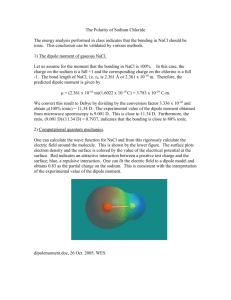
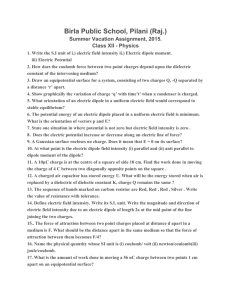

![Sample_hold[1]](http://s2.studylib.net/store/data/005360237_1-66a09447be9ffd6ace4f3f67c2fef5c7-300x300.png)

